
Annual Bulletin 2, 1978-1979
Home
Français
Introduction
History
Annual Index
Author &
Subject
Credits
Contact
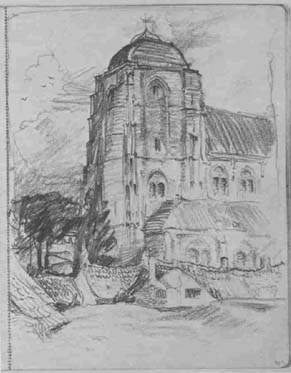
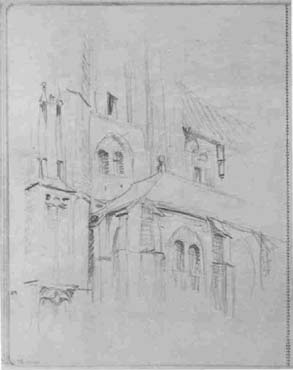
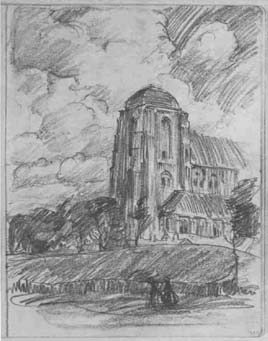
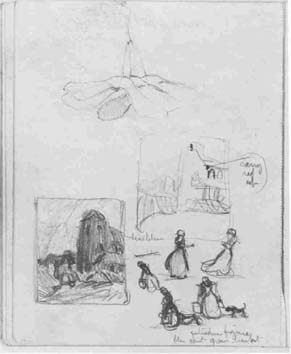

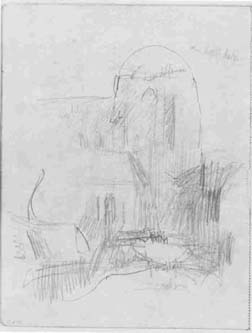
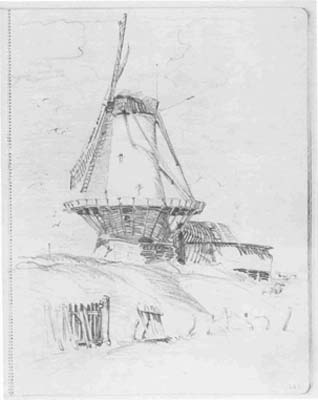
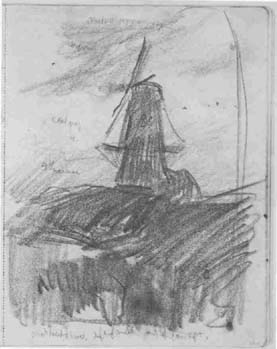

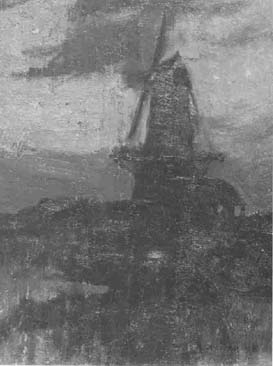
A. Y.
Jackson in France, Belgium and Holland:
A 1909 Sketch book
by Rosemarie L. Tovell
Pages 1
| 2 | 3
| 4
| 5
The Tonal Coding System
The crude beginnings of another working method can be seen developing
in the sketchbook. Almost all of Jackson's mature pencil sketches have
a numbered tonal code designed for quick recording of a subject that could
later be worked up in oil. The code was useful to Jackson when circumstances
did not permit him to make oil sketches on the spot. The numbers range
from 1 (lightest or white) to 10 (darkest or black). A landscape of trees
and what is probably the village of Episy, on page 5 recto (fig. 1),
has all the colours written out in long hand. The result is rather
cumbersome, with arrows pointing to areas to which the colour notation
applies. The drawing of the windmill at night on page 32 recto (fig. 15)
shows both the colour noted in long hand and tones in numbered code.
The study of the windmill on page 1 verso (fig. 16) shows only the
code, but in this case Jackson is working out only the broad areas. By comparing
the study of the windmill with the oil painting, Dutch Windmill at Night
(fig. 17), we can see that the code records only general values (i.e.
light to dark) without the inclusion of the general tones (i.e. shades
of a particular colour) that Jackson later incorporated into the system.
This is not the first time A. Y. Jackson used the numbered code. A drawing
dated c. 1907, of a park in Paris
(NGC collection) is inscribed with the code. The sketchbook, however,
indicates that by 1909 Jackson was beginning to use it extensively, though
he had not perfected it.
Drawings Preliminary to Canvases
The 1909 sketchbook is rich in preliminary drawings for paintings
of Dutch and French subjects done that year. Jackson's working methods
are brought to light further when the drawings are examined in conjunction
with what we know of these paintings.
The seven drawings of the Goote Kerk,
Veere, are studies for what were meant to be two separate works in oil. In the first series, the cathedral is seen from the southwest corner. Three
studies are found in what seems to be chronological order, on pages 30
recto, 28 verso and 33 recto (figs 8, 9, 10); two
small studies are found on page 23 verso (fig. 11). The drawing
on page 30 recto (fig. 8) is a highly-finished study of the church;
the artist has observed and recorded the details that make this cathedral
different from all others. The drawings, on page 28 verso (fig. 9),
which is perhaps the next drawing in the series, is a detailed study
of the exterior walls of the tower and the southwest chapel. In the drawing
on page 33 recto (fig. 10), the cathedral is pushed further into
the distance and the details are reduced to a minimum, so that the drawing
is more a study of light and form. This is the drawing Jackson remembered
as coming "closest to the painting which was probably destroyed." (21) The
studies on page 23 verso (fig. 11) confirm Jackson's memory for
they show two framed examples, probably made in his studio, of the page
33 recto (fig. 10) composition with notations on colour and tone
changes ("carry up red," "less blue") indicating that a rendering in oil
was well underway. The figures on this sheet are probably also preparations
for this oil, since they are remarkably similar to the two foreground figures
on the page 33 recto drawing and since they also have colour notations
("blue skirt," "green bucket").
In the second series, or perhaps first
series - the order is impossible to determine - the cathedral is viewed from
the northwest corner. The two drawings are found on pages 25 recto and
18 verso (figs 12 and 13) with value notations on page 20 recto
(fig. 7). The page 25 recto (fig. 12) drawing is another careful
study of the architectural details, drawn during the day. It is followed
chronologically by the drawing on page 18 verso (fig. 13). This
drawing shows value notations ("top slightly darker", "lighter," "less
difference") indicating that the oil - which has not been located, and
probably has been destroyed - was well underway. The awkwardness of this
drawing, for example the inaccurate attempts at shading, seems to indicate
that it was made on the spot at night. The time the second drawing was
made is underlined by the existence of value notations on page 20 recto
(fig. 7). These notations, written over a slight drawing, clearly were
meant for a dimly-lit church subject. The notations were probably made
separately on the nearest and most convenient page since Jackson would
not have been able to see well enough in the dark to place them appropriately
on the drawing (fig. 13). As in the first series of cathedral drawings,
A. Y. Jackson reduces the subject from detailed study to sculptural mass.
A similar breakdown from specific, accurate rendering to studies of pure
light, form, and atmosphere can be seen in the drawings for Dutch Windmill
by Night, on pages 26 recto, 32 recto, and 1 verso
(figs 14, 15, 16).
These three separate series of drawings
show us several ways in which A. Y. Jackson worked. The drawings such as
those on pages 25 recto, 30 recto, 33 recto and
26 recto (figs 12, 8, 10 and 14) render the subject as it was first
seen, and include perhaps, a few ideas for a possible reworking in oil.
The drawings have no colour notations, which indicates they were done before it was time for
Jackson to concern himself with colour, for the purpose of an oil sketch
for example. The other drawings, such as those on pages 18 verso, 32
recto and 1 verso (figs 13, 15 and 16), show that if further
studies were to be done on the spot, especially at night, then the drawings
served as quick notes to "push" the oil along. Such drawings could
also be done in the studio if the rethinking of a composition was minor
and did not require an oil sketch, as the drawing on page 23 verso (fig.
11) may indicate.
The canvas of the southwest view of the Groote Kerk is now lost, as is the
oil sketch of the northwest view.
From the colour notes that can be deciphered, the paintings seem to have
been relatively dark, concentrating on the mass of the cathedral and
its silhouette against a sombre blue sky.
The total effect must have been very close to the oil sketch Dutch
Windmill by Night (fig. 17) painted
at the same time and also based on a series of drawings in the sketch book. In this oil sketch, for which there probably never was a canvas, Jackson
shows his debt to contemporary Dutch artists such as Mauve and the Maris
brothers, whose work he went to see as the Rijksmuseum. The oil sketch
is remarkably close to the drawing on page 32 recto (fig. 15) and,
based on the amount of value coding,
was probably worked up from that drawing alone. Considering the final form
the cathedral and windmill took in oil and pencil, and looking at the
first detailed drawings, it is obvious that A. Y. felt he had to capture
every nuance of his subject before he could reduce or abstract it with
any degree of confidence or integrity.
Next Page | pages 35 recto and 35 verso
1
| 2 | 3
| 4
| 5
Annual Index | Author & Subject | Credits | Contact
This digital collection
was produced under contract to Canada's Digital Collections program,
Industry Canada.
"Digital
Collections Program, Copyright
© National Gallery of
Canada 2001"